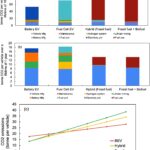
Nvidia made history by becoming the first company ever to surpass a $5 trillion market capitalization.
Shares of the chipmaker rose more than 3% today (October 29) at the market open, extending the company’s incredible run as the primary corporate winner of the global artificial intelligence boom.
The news comes amid mounting investor enthusiasm surrounding Nvidia’s dominance in AI infrastructure and optimism about future global sales. The milestone underscores how essential the company’s graphics processing units (GPUs) have become to powering AI models across industries — from cloud computing to autonomous vehicles.
Trump fuels optimism about China sales
Investor sentiment was further lifted after remarks from President Trump suggested a potential breakthrough in Nvidia’s strained relationship with China. Ahead of a planned meeting with Nvidia CEO Jensen Huang, Trump told reporters he and Huang would be “speaking about Blackwells,” referring to the company’s next-generation AI chips.
A modified version of the Blackwell chip could reportedly win approval for export to China, marking a possible shift in the US-China tech dynamic. Nvidia’s most recent quarterly report, released on August 27, showed no sales of its older H20 chips to China. Although the White House announced in July that it had negotiated a deal allowing H20 chip exports in exchange for a 15% revenue cut, Nvidia said the agreement had not yet been finalized.
Any renewed access to China’s lucrative AI hardware market would be a major boost to Nvidia’s future sales potential, given Beijing’s aggressive push to develop domestic AI capabilities.
Expanding partnerships
The company’s record-breaking moment also followed a string of announcements at its GTC event in Washington, D.C., which drew significant investor attention. Huang’s keynote framed Nvidia’s role as the driving force behind a “new industrial revolution,” powered by AI infrastructure and what he called “AI factories that generate intelligence at scale.”
Among the highlights:
- Supercomputers: Nvidia is collaborating with the U.S. Department of Energy to build seven new supercomputers, including one using 10,000 Blackwell GPUs.
- New industry partnerships: Deals with Uber to develop self-driving fleets, and Eli Lilly for AI-powered drug discovery, underscore Nvidia’s expanding reach across sectors.
- Telecom and connectivity: Partnerships with Nokia, Cisco, and T-Mobile aim to accelerate the development of next-generation 6G networks.
- Enterprise collaboration: The company announced new tie-ups with Oracle and Palantir to integrate Nvidia’s AI capabilities into enterprise systems.
- Quantum computing: Nvidia revealed an open systems architecture, NVQLink, designed to advance quantum supercomputing through partnerships with Rigetti and IonQ.
These announcements illustrate Nvidia’s ambition to embed its chips and platforms across every major technology frontier — from healthcare to telecommunications and advanced research.
Growth and market context
Nvidia’s financial performance continues to defy expectations. The company has already reported more than $100 billion in revenue for the first half of the year and projects $500 billion in GPU sales by the end of 2026.
Its stock has climbed over 50% in 2025, more than doubling from its April lows after Trump’s “Liberation Day” tariff announcements briefly disrupted markets. The rally has also contributed to broader market gains, with the S&P 500 hitting record highs.
As of Wednesday morning (October 29), Nvidia shares traded at $210.09, up 4.51%, further cementing its position as the centerpiece of the AI investment narrative.
Competitive landscape
Despite Nvidia’s dominance, competition in the AI chip sector is intensifying. AMD recently signed deals with OpenAI for up to 6 gigawatts of AI processors and with Oracle for 50,000 GPUs. Qualcomm has also entered the fray, announcing its own AI accelerator chips aimed at data centers.
Moreover, Nvidia’s biggest customers — including Amazon, Google, and Microsoft — are developing in-house AI chips to reduce dependency on the company’s hardware. This growing self-reliance could pose long-term challenges to Nvidia’s market share.
Still, for now, Nvidia remains the undisputed leader in AI computing, both technologically and financially. Its continued growth symbolizes not only the power of AI-driven transformation but also the geopolitical and economic stakes of controlling the chips that make AI possible.
Nvidia said it will invest $1 billion in Nokia, taking a nearly 3% stake in the Finnish telecommunications firm to strengthen collaboration on AI-driven networking and data center technologies.
This article was reviewed by Antony Peyton.










